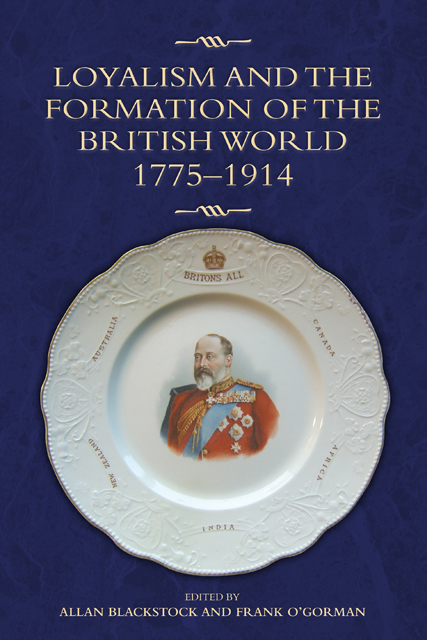Book contents
- Frontmatter
- Contents
- Notes on Contributors
- 1 Loyalism and the British World: Overviews, Themes and Linkages
- 2 Origins and Trajectories of Loyalism in England, 1580–1840
- 3 The ‘Spirit of Loyalty’: Material Culture, Space and the Construction of an English Loyalist Memory, 1790–1840
- 4 Anti-Catholicism and Orange Loyalism in Nineteenth-Century Britain
- 5 Loyalty and the Monarchy in Ireland, c.1660–c.1840
- 6 The Trajectories of Loyalty and Loyalism in Ireland, 1793–1849
- 7 Presbyterians, Loyalty and Orangeism in Nineteenth-Century Ulster
- 8 Unionists and Patriots: James Whiteside, the Irish Bar and the Dilemmas of the Protestant Nation in Victorian Ireland
- 9 Loyalism in British North America in the Age of Revolution, c.1775–1812
- 10 ‘A Colonial Hybrid’: Nineteenth-Century Loyalism as Articulated by the Orange Order in the Maritime Colonies of British North America
- 11 Canadian Catholics, Loyalty, and the British Empire, 1763–1901
- 12 Loyalism in Australasia, 1788–1868
- 13 ‘We love one country, one queen, one flag’: Loyalism in Early Colonial New Zealand, 1840–80
- 14 Clientelism, Community and Collaboration: Loyalism in Nineteenth-Century Colonial India
- Select bibliography
- Index
12 - Loyalism in Australasia, 1788–1868
Published online by Cambridge University Press: 28 February 2023
- Frontmatter
- Contents
- Notes on Contributors
- 1 Loyalism and the British World: Overviews, Themes and Linkages
- 2 Origins and Trajectories of Loyalism in England, 1580–1840
- 3 The ‘Spirit of Loyalty’: Material Culture, Space and the Construction of an English Loyalist Memory, 1790–1840
- 4 Anti-Catholicism and Orange Loyalism in Nineteenth-Century Britain
- 5 Loyalty and the Monarchy in Ireland, c.1660–c.1840
- 6 The Trajectories of Loyalty and Loyalism in Ireland, 1793–1849
- 7 Presbyterians, Loyalty and Orangeism in Nineteenth-Century Ulster
- 8 Unionists and Patriots: James Whiteside, the Irish Bar and the Dilemmas of the Protestant Nation in Victorian Ireland
- 9 Loyalism in British North America in the Age of Revolution, c.1775–1812
- 10 ‘A Colonial Hybrid’: Nineteenth-Century Loyalism as Articulated by the Orange Order in the Maritime Colonies of British North America
- 11 Canadian Catholics, Loyalty, and the British Empire, 1763–1901
- 12 Loyalism in Australasia, 1788–1868
- 13 ‘We love one country, one queen, one flag’: Loyalism in Early Colonial New Zealand, 1840–80
- 14 Clientelism, Community and Collaboration: Loyalism in Nineteenth-Century Colonial India
- Select bibliography
- Index
Summary
There’ll be royal times in Sydney for the Cuff and Collar Push,
There’ll be lots of dreary drivel and clap-trap
From the men who own Australia, but who never knew the Bush,
And who could not point their runs out on the map.
Oh, the daily Press will grovel as it never did before,
There’ll be many flags of welcome in the air,
And the Civil Service poet, he shall write odes by the score-
But the men who made the land will not be there.
You shall meet the awful Lady of the latest Birthday Knight-(She is trying to be English, don’t-cher-know?)
You shall hear the empty mouthing of the champion blatherskite,
You shall hear the boss of local drapers blow.
There’ll be ‘majahs’ from the counter, tailors’ dummies from the fleet,
And to represent Australia here to-day,
There’s the toady with his card-case and his cab in Downing-street;
But the men who made Australia-where are they?
Henry Lawson (Royal Visit 1901)The Old ‘Australian Legend’, publicised by the Sydney Bulletin and writers like Henry Lawson in the 1890s, depicted Australians as bronzed, independent, outback pioneers, radical Labor in politics, intolerant of authority, and deeply suspicious of the British establishment. Early Australian historians maintained that convicts, providing the initial colonising impulse, were generally ‘village Hampdens’ transported for semi-political or minor offences. Henry Reynolds argues that the English deference which authorities like Governor George Arthur of Van Diemen’s Land tried to brutally force upon convicts had the opposite effect of instilling irreverence in emancipists and their descendants. The Australian Labor Party was exalted as the motive force of Australian development. Across the Tasman, historians likewise emphasised radical Liberals and the New Zealand Labour Party as the source of New World social experimentation, later copied in Europe. Before Australian Federation in 1900 New Zealand was then one of a group of separate Australasian colonies. Victoria and Queensland were part of New South Wales until 1851 and 1859 respectively and Western Australia was garrisoned by New South Wales from 1826 to 1831. Van Diemen’s Land, originally under New South Wales’s jurisdiction, was started as a convict colony in 1803, but South Australia was settled by free immigrants after 1836. This chapter will mainly consider Australian colonies, with some cross-references to similar developments in New Zealand.
- Type
- Chapter
- Information
- Loyalism and the Formation of the British World, 1775-1914 , pp. 223 - 240Publisher: Boydell & BrewerPrint publication year: 2014
- 1
- Cited by



